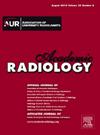基于多参数mri的机器学习放射组学预测不可切除肝细胞癌经动脉化疗栓塞联合靶向和免疫治疗的治疗反应:一项多中心研究。
IF 3.8
2区 医学
Q1 RADIOLOGY, NUCLEAR MEDICINE & MEDICAL IMAGING
引用次数: 0
摘要
基本原理和目标:开发和验证结合临床特征和预处理多参数磁共振成像(MRI)放射学特征的多种机器学习预测模型,用于预测不可切除肝细胞癌(HCC)经动脉化疗栓塞联合分子靶向治疗加免疫治疗的治疗反应。材料和方法:本回顾性研究包括来自4个医疗中心的276例接受联合治疗的不可切除HCC患者。患者被分为一个训练队列和两个独立的外部验证队列。利用来自6个多参数MRI序列的16个放射学特征和2个临床特征构建6个机器学习模型。使用曲线下面积(AUC)、决策曲线分析和增量预测值对模型进行评估。结果:甲胎蛋白和中性粒细胞与淋巴细胞比值是治疗反应的临床独立预测因子。在训练队列和两个外部验证队列中,临床模型预测治疗反应的auc和95%置信区间分别为0.782(0.698-0.857)、0.695(0.566-0.823)和0.679 (0.542-0.810);放射组学模型为0.942(0.903-0.974)、0.869(0.761-0.949)、0.868 (0.769-0.942);临床-放射组学联合模型为0.956(0.920-0.984)、0.895(0.810-0.967)、0.892(0.804-0.957)。在三个队列中,放射组学模型相对于临床模型的增量预测值为49.2% (P)。结论:临床-放射组学联合模型可为预测HCC患者的个体化治疗反应提供可靠且无创的工具,指导和改善HCC患者联合治疗的临床决策。本文章由计算机程序翻译,如有差异,请以英文原文为准。
Multiparametric MRI-based Machine Learning Radiomics for Predicting Treatment Response to Transarterial Chemoembolization Combined with Targeted and Immunotherapy in Unresectable Hepatocellular Carcinoma: A Multicenter Study
Rationale and Objectives
To develop and validate multiple machine learning predictive models incorporating clinical features and pretreatment multiparametric magnetic resonance imaging (MRI) radiomic features for predicting treatment response to transarterial chemoembolization combined with molecular targeted therapy plus immunotherapy in unresectable hepatocellular carcinoma (HCC).
Materials and methods
This retrospective study involved 276 patients with unresectable HCC who received combination therapy from 4 medical centers. Patients were divided into one training cohort and two independent external validation cohorts. 16 radiomic features from six multiparametric MRI sequences and 2 clinical features were used to build six machine learning models. The models were evaluated using the area under the curve (AUC), decision curve analysis, and incremental predictive value.
Results
Alpha-fetoprotein and neutrophil-to-lymphocyte ratio are clinical independent predictors of treatment response. In the training cohort and two external validation cohorts, the AUCs and 95% confidence intervals for predicting treatment response were respectively 0.782 (0.698-0.857) 0.695 (0.566–0.823), and 0.679 (0.542–0.810) for the clinical model; 0.942 (0.903–0.974), 0.869 (0.761–0.949), and 0.868 (0.769–0.942) for the radiomics model; and 0.956 (0.920–0.984), 0.895 (0.810–0.967), and 0.892 (0.804–0.957) for the combined clinical-radiomics model. In the three cohorts, the incremental predictive value of the radiomics model over the clinical model was 49.2% (P < 0.001), 28.8% (P < 0.001), and 31.5% (P < 0.001).
Conclusion
The combined clinical-radiomics model may provide a reliable and non-invasive tool to predict individual treatment responses and guide and improve clinical decision-making in combination therapy of HCC patients.
求助全文
通过发布文献求助,成功后即可免费获取论文全文。
去求助
来源期刊

Academic Radiology
医学-核医学
CiteScore
7.60
自引率
10.40%
发文量
432
审稿时长
18 days
期刊介绍:
Academic Radiology publishes original reports of clinical and laboratory investigations in diagnostic imaging, the diagnostic use of radioactive isotopes, computed tomography, positron emission tomography, magnetic resonance imaging, ultrasound, digital subtraction angiography, image-guided interventions and related techniques. It also includes brief technical reports describing original observations, techniques, and instrumental developments; state-of-the-art reports on clinical issues, new technology and other topics of current medical importance; meta-analyses; scientific studies and opinions on radiologic education; and letters to the Editor.
 求助内容:
求助内容: 应助结果提醒方式:
应助结果提醒方式:


